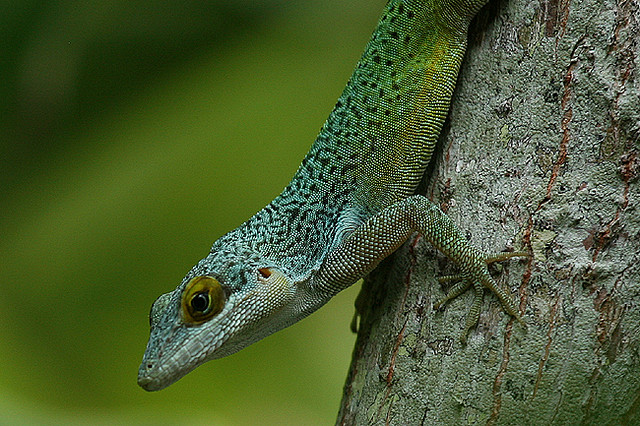
Panther anole (Anolis leachi)
Phylum —chordata
Class — reptilia
Order — squamata
Family — dactyloidae
Genus – anolis
Appearance
It is about 11 cm long. They have a long, thin tail, often exceeding the length of the body. The color is bright green, with blurred stripes and spots on the head and sides of the body.
Habitat
Panther anoleis native to Antigua and Barbuda, an island-nation in the Caribbean Lesser Antilles, where it can be found on both main islands. It has also been introduced to Bermuda.
Behavior
It leads an arboreal lifestyle and is almost never climb down on the ground.
Panther anoles are a diurnal species. In both males and females, the majority of the day is dedicated to foraging.Behavior changes slightly during the breeding season, when males dedicate more time to social interactions such as courting females.
Diet
They eat insects, spiders, and sometimes small fruits.
Reproduction
It is an oviparous species. The female lays 2 to 4 eggs.
In captivity
Lifespan is up to 4 years.
It is better to keep anoles in groups of one male and several females, in a vertical terrarium, the walls of which are decorated with bark and other materials that allow the lizards to move on vertical surfaces. The main volume of the terrarium is filled with branches of various thicknesses.
A humidity level of 60 to 70 percent is necessary for anoles (use a hygrometer to monitor these levels). This can usually be achieved by misting the inside of the tank daily. Misting systems are available although they are quite expensive. If you are having a hard time maintaining the humidity level try covering part of the top of the tank and/or increasing the number of live plants in the enclosure. Misting also provides drinking water for the anoles as they often will not drink from a bowl (they will lick droplets of water off the misted plants like chameleons).
During the day be sure to provide a thermal gradient from 75 to 80 F (24 to 27 oC) with a basking spot of 85 to 90 F (29 to 32 oC). A combination of under tank heaters and a basking light on one side of the tank works well. Make sure the appropriate temperature gradient is provided by measuring temperatures in various spots around the tank. Night temperature can drop to a gradient of 65 to 75 F (18 to 24 oC). Do not use white basking lights to achieve nighttime temperatures but instead use heating pads, ceramic heating elements, or special night heat lights.
In addition to the incandescent basking light, you should provide a full spectrum UVA/UVB light for 10 to 12 hours per day. This special light will help prevent your anole from developing metabolic bone disease and keep them looking brightly colored, active, and happy. The bulb needs to be changed out every six months (even if it hasn't burned out) and nothing should be blocking the light other than a metal mesh screen (no plastic or glass).
A substrate of peat moss and soil with or without a layer of bark (e.g. orchid bark) is an ideal substrate for anoles. Live plants help maintain humidity and provide cover. Favorite live plants include sansevierias (snake plants), bromeliads, philodendrons, ivy, orchids, and vines. Avoid oily or scented substrates such as wood shavings, and stay away from very dry substrates such as sand.
Anoles are insectivores and are generally good eaters. While crickets can be the main part of the diet, it is best to feed a variety of gut loaded insects including mealworms and wax worms. Feed two to three appropriately-sized prey items that are about half the size of the anole's head every other day. A calcium and vitamin supplement should also be dusted on the insects.
In general, anoles are hardy animals and are rarely ill. They can, however, develop respiratory issues, mouth rot, or a metabolic bone disease that results in weight loss and swollen joints. Look for:
- swollen joints;
- loss of appetite;
- smelly or runny stool;
- weight loss;
- difficulty breathing;
- discharge from nose, eyes or mouth;
- shedding problems or discolored skin.
You should always consult a veterinarian if you see any of these problems. Meanwhile, however, do check to be sure that your pet's substrate and diet are appropriate, as problems with these are often the cause of stress-related illness.
 Russian
Russian
 English
English























